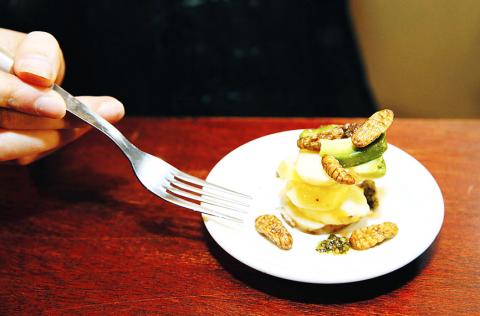At a tiny bar in Paris’ Montmartre district, chef Elie Daviron is happy to admit his new menu has disgusted some clients, while others need two or three drinks before they can face it.
Amid the guacamole, chicken tikka and chili hotdogs, the young chef is conducting a “gastronomical experiment” with what he calls a selection of “insect tapas.”
Grasshoppers, beetles, scorpions and two different types of worm — sango and silk — are the latest additions to his fare.

Photo: AFP
“My personal favorite is the sango worm,” Daviron said from behind the bar of the Festin Nu or Naked Lunch, a watering hole in the picturesque northern slope of the Montmartre hill.
“There are two textures ... you have the head and the body which are a completely different taste and flavor,” he said.
The body was “sandy” tasting, while the head was “crunchy” and tasted a bit like a combination of beetroot and mushrooms, he added.

Photo: AFP
The 26-year-old from Montpellier became interested several years ago in the idea of how insects could in future be a common source of protein in Europe. And after the release of a UN report on edible insects earlier this year, he “realized that people were waiting for someone to do that.”
Daviron ordered a selection from a company licensed to import dried insects and set about experimenting with recipes.
The result was five dishes, including scorpion with pepper cooked in olive oil, beetle with cucumber, ginger pickle and green peas, and grasshopper with egg.
The protein-rich insects are imported from Thailand where they are widely eaten as snacks.
However, due to limited demand in France the few licensed suppliers deal only in dried insects rather than frozen or fresh.
“They are dried and salted and the taste will be a bit related to that,” he said, adding that because they are dried, they do not need cooking and so retain the appearance of the insect.
“It will be fermented taste, mushroom taste, dried fruit taste, dried meat taste, dried fish taste, a lot of things around that,” he said.
“The grasshopper will be more like hazelnuts and the giant water scorpions will be closer to dried fish,” he added.
Student Laura Dandelot, 21, said she had to overcome her prejudices in order to try the scorpion.
“At first, I did think it was disgusting and impossible to eat because it was strange and dirty,” she said.
In fact, the scorpion tasted pleasant enough, she said, describing it as a bit “like nuts,” although she did not like the texture.
“It was very hard to eat... crispy and hard,” she added.
Adele Gaudre, also a 21-year-old student, said she liked the grasshopper.
“It was as if you were chewing on dried tea. It was really dry, but very nice,” she said.
The “insect tapas” are priced at between five and nine euros (US$7 and US$12) per serving, and on a busy night the bar dishes up about 50 such plates.
Daviron said in the two weeks since he put the insects on the menu, he had witnessed a range of reactions from customers.
“Some [people] are curious, some are disgusted, some are enthusiastic, some just don’t want to hear about that,” he said.
“Some get into the game or maybe they wait [until] after one or two or three drinks to get started,” he said.
According to a Food and Agriculture Organisation report this year, insects although not eaten in Western nations form part of the diet of about 2 billion people worldwide, mainly in Asia and Africa.
Daviron said he was confident that in the long term other countries would overcome their reservations too.
“The disgust is really turning into a fascination,” he said.
“It is difficult to say how fast and in what form it will actually become an everyday event,” he said.
“Maybe not tomorrow. It will take time... but it may be faster than we think,” he said.

WEAKER ACTIVITY: The sharpest deterioration was seen in the electronics and optical components sector, with the production index falling 13.2 points to 44.5 Taiwan’s manufacturing sector last month contracted for a second consecutive month, with the purchasing managers’ index (PMI) slipping to 48, reflecting ongoing caution over trade uncertainties, the Chung-Hua Institution for Economic Research (CIER, 中華經濟研究院) said yesterday. The decline reflects growing caution among companies amid uncertainty surrounding US tariffs, semiconductor duties and automotive import levies, and it is also likely linked to fading front-loading activity, CIER president Lien Hsien-ming (連賢明) said. “Some clients have started shifting orders to Southeast Asian countries where tariff regimes are already clear,” Lien told a news conference. Firms across the supply chain are also lowering stock levels to mitigate

Six Taiwanese companies, including contract chipmaker Taiwan Semiconductor Manufacturing Co (TSMC, 台積電), made the 2025 Fortune Global 500 list of the world’s largest firms by revenue. In a report published by New York-based Fortune magazine on Tuesday, Hon Hai Precision Industry Co (鴻海精密), also known as Foxconn Technology Group (富士康科技集團), ranked highest among Taiwanese firms, placing 28th with revenue of US$213.69 billion. Up 60 spots from last year, TSMC rose to No. 126 with US$90.16 billion in revenue, followed by Quanta Computer Inc (廣達) at 348th, Pegatron Corp (和碩) at 461st, CPC Corp, Taiwan (台灣中油) at 494th and Wistron Corp (緯創) at

IN THE AIR: While most companies said they were committed to North American operations, some added that production and costs would depend on the outcome of a US trade probe Leading local contract electronics makers Wistron Corp (緯創), Quanta Computer Inc (廣達), Inventec Corp (英業達) and Compal Electronics Inc (仁寶) are to maintain their North American expansion plans, despite Washington’s 20 percent tariff on Taiwanese goods. Wistron said it has long maintained a presence in the US, while distributing production across Taiwan, North America, Southeast Asia and Europe. The company is in talks with customers to align capacity with their site preferences, a company official told the Taipei Times by telephone on Friday. The company is still in talks with clients over who would bear the tariff costs, with the outcome pending further

NEGOTIATIONS: Semiconductors play an outsized role in Taiwan’s industrial and economic development and are a major driver of the Taiwan-US trade imbalance With US President Donald Trump threatening to impose tariffs on semiconductors, Taiwan is expected to face a significant challenge, as information and communications technology (ICT) products account for more than 70 percent of its exports to the US, Chung-Hua Institution for Economic Research (CIER, 中華經濟研究院) president Lien Hsien-ming (連賢明) said on Friday. Compared with other countries, semiconductors play a disproportionately large role in Taiwan’s industrial and economic development, Lien said. As the sixth-largest contributor to the US trade deficit, Taiwan recorded a US$73.9 billion trade surplus with the US last year — up from US$47.8 billion in 2023 — driven by strong